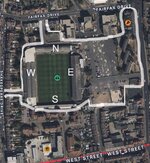@North Wales Shrimper @Cricko
According to Peter Mason's excellent book:
"The pitch ran from north to south, as it does today, and although it had a pronounced slope from one end to the other, it was judged a satisfactory surface by the standards of the day."
"...when the First World War put a stop to the Southern League two years later a dispute developed over outstanding rent. Southend tried to generate money by sub-letting Roots Hall to the military, but by June 1916 when the lease ran put, there was no option than for the owner George Radford to hold an auction of Roots Hall assets to raise money...A week later work begun on
digging the pitch into allotments.
[Soon after the end of the First World War]...it's
[Roots Hall] new owners, Southend Gas Company, discovered large deposits of sand on the site. The firm had originally intended to erect a Gas Holder on the land, but the inter war housing boom in Southend had created a huge demand for sand, so the opportunity at Roots Hall was too good to miss.
When the sandpit was exhausted most of the area was taken over by the Gas Light & Coke Company, which used the huge hole created by quarrying as a dump for old cookers, piping and other gas related paraphernalia. Locals also took to throwing rubbish in the pit..."
Hope this helps tidy up a few inaccuracies concerning our route to 'The Hall' as we know it.


















